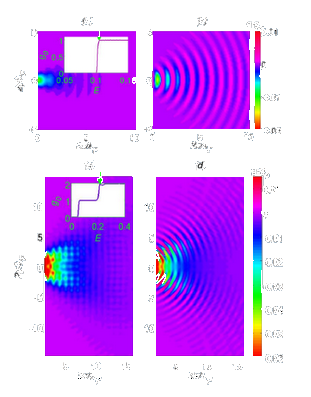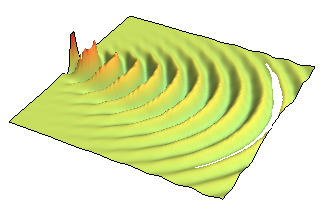Quantum physics and low dimensional systems
|
Theory of Scanning Gate Microscopy
Scanning gate microscopy (SGM) is a technique of imaging the change in a physical observable induced by the presence of an Atomic Force Microscope charged tip. The change of the position of the tip leads to the obtaintion of figures of interference effects. Different systems can be studied by this method: Quantum point contacts (QPC), quantum rings ... The figures of intereference pattern obtained with this technique are studied and explained using theoritical tools such as semiclassical theory of scattering and Green's functions. We also find numerical programs based on recursive Green's function which when combined with simplified models provides interesting answers such as the decay law of the fringes in QPC obtained in 2DEG. The different question we can investigate are:
|
|
|
Thermal enhancement of the interference effects in quantum point contacts (QPC): The effect of a charged tip on the conductance of a QPC depends on the opening of the system. If the QPC is fully open for one mode of conduction (first plateau) the effect decays as 1/x2. If now the system is less open, the decay law of the tip's effect becomes 1/x. Because of this difference in the behaviour on the plateau and on the step of the conductance profile, we find that a system fully open at the edge of the plateau can show a conterintuitive effect of enhancement of the fringes by temperature increase! This interesting effect is shown numerically and explained analytically assuming simple resonant level model. More details can be found in Phys. Rev. Lett. 106, 156810 (2011). This effect of thermal enhancement of the fringes is actually more general and can be seen for the higher plateaus of conduction as it can be seen in the figures. The simulation is done on realistic models using the consept of recursive Green's functions. The system which includes the quantum point contact and the charged tip acts as a quantum interferometer. The behavior of this interferometer can be explained by studying the semiclassical paths of the electrons. These examples show how simple models, taking into account the pertinent parameters of a problem can give interesting answers and provide the same results as the original system with an analytical description at the same time. From Phys. Rev. Lett. 106, 156810 (2011). |
|
Scanning gate microscopy of the Seebeck coefficent :
In a Quantum point contact, connected to two electronic reservoirs set to slightly different temperatures, we can aquire the difference of the potential induced in order to access to the Seebeck coefficient. Now, with an AFM charged tip, we can image the change in the in the Seebeck coefficient as done in the usual Scanning gate experiment. Here again , we can try to give the decay law of the fringes as a function of the tip position. For more details, you can look at the thesis here. |



